Home Donate New Search Gallery How-To Books Links Workshops About Contact
How to Carry Less
© 2008 KenRockwell.com. All rights reserved.
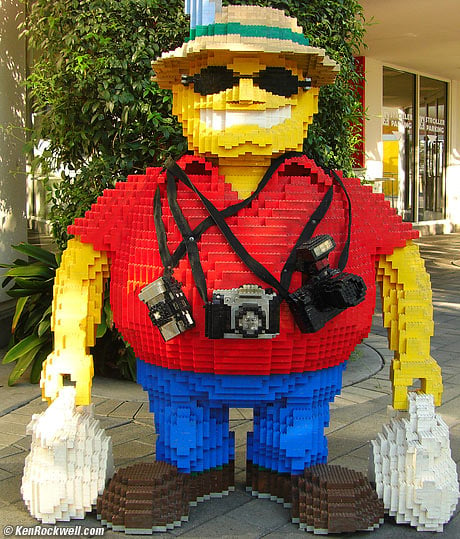
Carrying too much, 1960s.
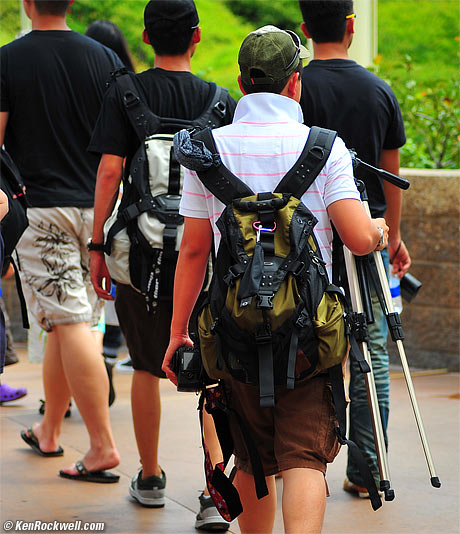
The 2000s. These guys might enjoy carrying this all day, but they probably don't.
September 2008 Nikon Reviews Canon Reviews
See also The Two Pocket Shuffle and Assembling a System.
Introduction top
Trying to be prepared for everything makes you prepared for nothing.
When I was an 11-year-old kid with my first Minolta SLR, I use to carry a trunk case loaded with a slew of lenses everywhere I went.
Throughout the entire 1980s, I still would haul a huge bag loaded with two bodies and Nikkor 16mm Fisheye, 17mm, 24mm, 35mm, 50mm f/1.4, 55mm Micro, 105mm f/1.8 and 180mm f/2.8 ED lenses everywhere I went. I thought I was slimming down when I left the 50mm at home and started using the 55mm Micro as a normal lens, and when I replaced the heavy 105/1.8 with an 85/2 and replaced the big 180/2.8 with a smaller 200/4.
Today, I grab one camera, one lens, and go. I have more fun, and get far better pictures.
I took the wife and kids to Sea World, and all I brought was an FX camera and a crappy plastic 70-300mm G lens which sells for $119.95 brand new.
Why didn't I bring a "good" 70-300 VR ($500), 80-400mm VR ($1,600) or a 70-200mm f/2.8 ($1,700)? Simple: I didn't want to carry it around all day, and with digital, I don't need them. High ISOs look great and eliminate the need for fast lenses or VR in the daytime.
I snapped these in VIVID Picture Control with +3 saturation. These are all shot with the 70-300mm G, so I shifted my Program exposure mode a stop to the right (on the rear dial) to choose higher shutter speeds to eliminate motion blur. When you shift the rear dial to change the f/stop combinations used on any Nikon in Program, it shows as P* on the top LCD.
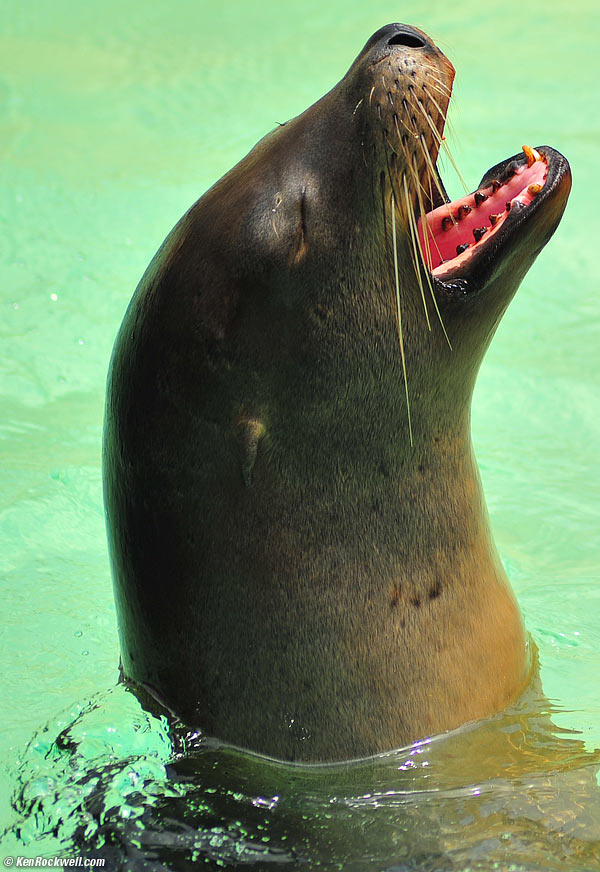
Seal. D3, 70-300G at 240mm, P* mode 1/500 @ f/5.6, Auto ISO chose ISO 200.

Egret. D3, 70-300G at 240mm, P* mode 1/1,000 @ f/8, Auto ISO chose ISO 200.
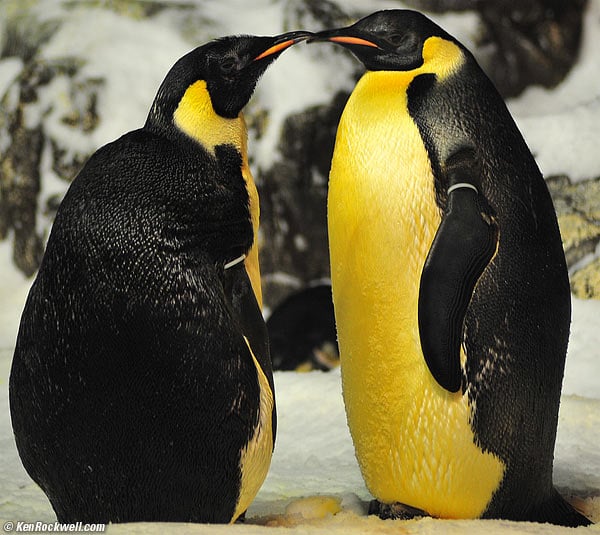
Cuddly Penguins. D3, 70-300G at 240mm, P* 1/125 @ f/5, Auto ISO chose ISO 1,600.

Calypso. D3, 70-300G at 180mm, P* mode 1/500 @ f/5.6, Auto ISO chose ISO 200.

Sea Antlers. D3, 70-300G at 180mm, P* Mode 1/1,000 @ f/8, Auto ISO chose ISO 200.
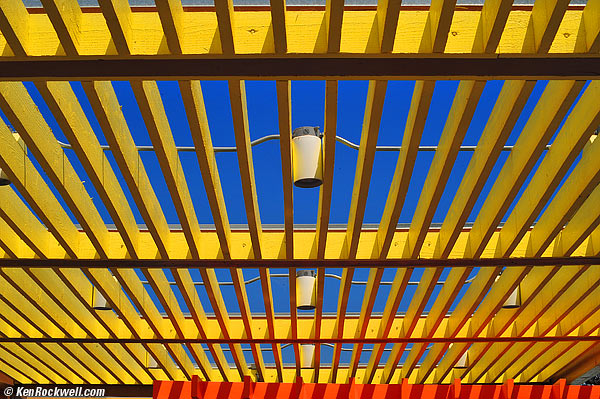
Lattices. D3, 70-300G at 70mm, P* mode 1/250 @ f/16, Auto ISO chose ISO 200.
The D3 doesn't weigh anything when you put the right lens on it, like the plastic 70-300mm G.
The next day, I packed up the family and we headed north to Legoland.
What lens did I bring to shoot on FX? I realized that I didn't need 300mm after yesterday's "big game" shoot at Sea World, so I grabbed my even smaller and lighter plastic Nikon 28-200mm G.
At Legoland, I saw guys carrying so much camera crap that they clearly were having no fun, and making no pictures either.
Carrying camera stuff is like travel. Those who travel the most take the least with them, because they've learned what they use, and take only that. Frequent travelers hone down what they take as they learn what items can serve a second purpose and replace something else. Infrequent travelers take everything they "might need," and wind up taking tons of stuff they don't use.
Photography is exactly like that. It seems that the guys who took too much stuff had never been out before, and wanted to be sure they carried everything they own in their backpack, their fanny pack, and made their wife carry another bag along with the two kids!
Here are some snaps from an hour at Legoland, all with one lens:
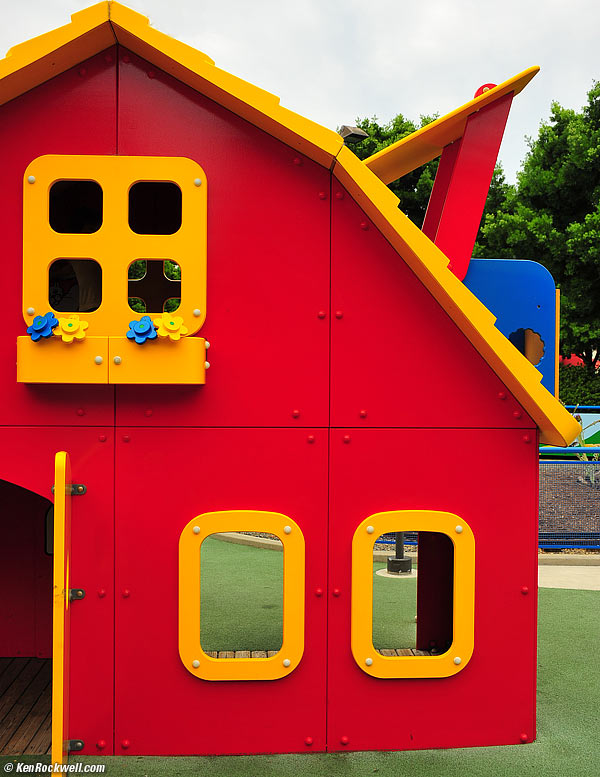
Legoland is loaded with primary colors.
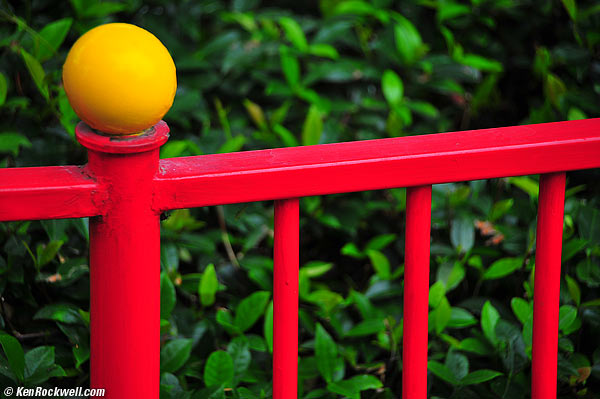
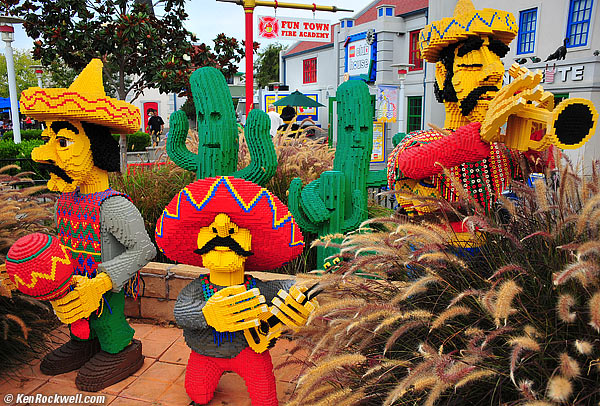
México! Got pixels? Everything is made of Lego blocks.
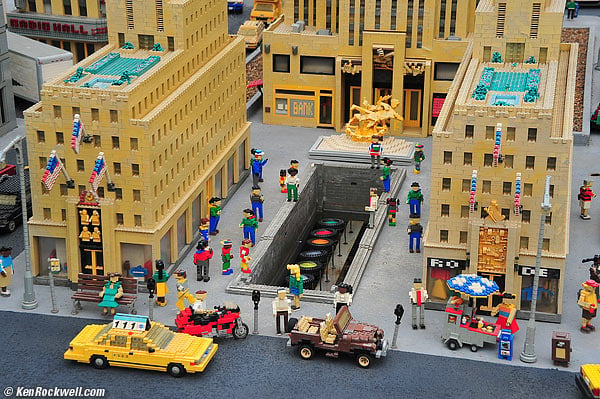
Rockefeller Center. Nikon House used to be in the front of the building on the left. Nikon House was the first place that I ever got to see a Nikon 13mm f/5.6 lens. This was back in the 1970s, and I never saw one again for 30 years until I got to play with another this January for an upcoming review. For all I know, it could have been the same sample of lens.
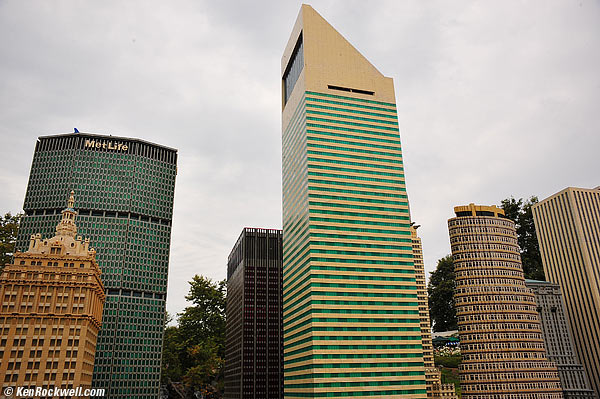
Downtown Manhattan, all without leaving San Diego.
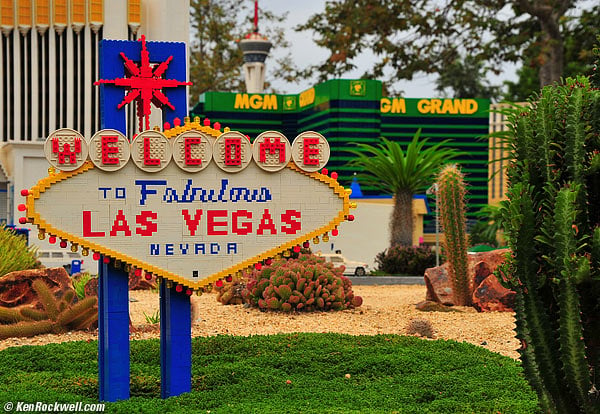
Now we're in Las Vegas!
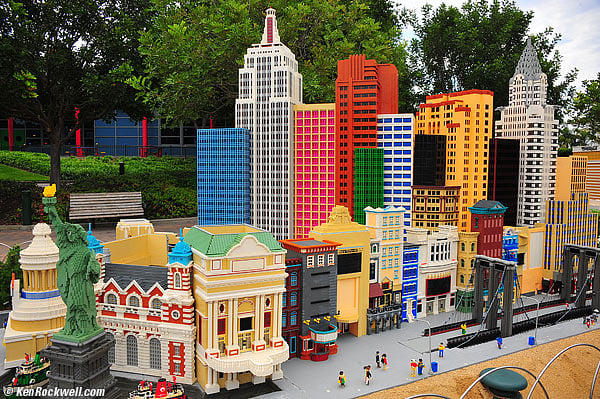
Wow, now we're back in New York, NY in Las Vegas.
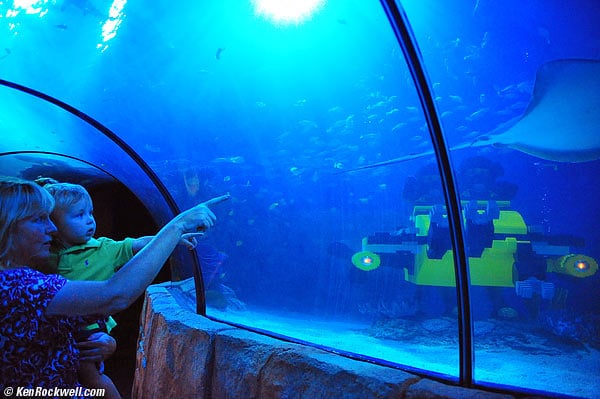
Legoland's new Sea Life Aquarium, which just opened this month. Everything is super-clean without the wear on the Plexiglas though which you have to shoot elsewhere. This shot has good gesture, and the for other shots I made (not shown here) I adjusted the WB much redder to compensate for the blue of the water.
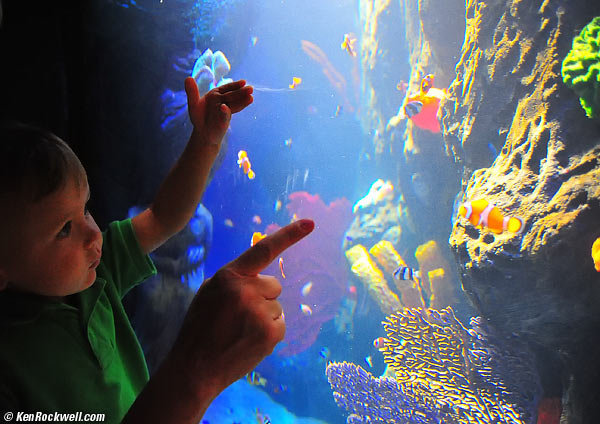
(All: Nikon D3, 28-200mm G, Program auto, Auto WB and Auto ISO.)
Discussion top
|
I personally buy from these stores. I can't vouch for ads below.
|
Camera makers, magazines, websites and camera stores do their best to brainwash you into thinking you need to buy everything, and that once you buy everything, that you have to take it with you. They subliminally plant the message that if you don't buy and carry every piece of gear you own, that you undoubtedly will miss the photographic opportunity of a lifetime, and be forever branded as a whimp.
Au contraire, the key to traveling and shooting well is to carry as little as possible. You feel better, see more, and shoot more clearly.
When I was in France for three weeks, all I took was one camera with a fixed normal lens. I never missed anything, and in fact, the one lens focused my seeing so I shot better and faster. Even shots for which I normally would have used something crazy like a 14mm lens, I shot with the normal lens. I never missed my 14mm, and I sure enjoyed not having to haul it and a bag of stuff all over France for three weeks.
The further you're going, the less you should carry.
A day in a park isn't a world trip, and even if it was, all you need is one lens, maybe two. The less you carry, the more you'll see and the more great photos you'll make. Galen Rowell, in his 1990s book "Mountain Light," shot around the world with his 24mm f/2.8, and occasionally his 75-150mm Series E. In later life, he went running with an N65.
If I'm shooting out of the trunk of my car, I may bring a trunk full of stuff I probably won't use.
If I have to walk around all day carrying what I bring, I'll bring a spare lens or two stuffed in jacket or shorts pockets, and that's it. I do not use camera bags, except to keep things from banging into each other in my trunk.
If you're carrying a camera bag, you're carrying too much. I know of no pros who use camera bags; they use belt systems if anything.
Bring Less, See More top
When I carry less, I see more because I automatically see everything in my minds' eye composed for the one or two lenses I've brought. I can drop accurate compositional rectangles over reality using just my imagination.
With a zoom or several lenses, I can't drop accurate rectangles over scenes in my head as I wander around. I don't see as clearly, and have to fumble with a camera to frame. It's much better to visualize your compositions without needing a camera.
With one lens, I never waste my time swapping lenses or wondering how something might look through another lens. I simply walk around, and see pictures without needing my camera. When I see a picture, I grab my camera, snap it and keep moving. It's faster and easier, and I'm never a target for crime while hunched over a bag of expensive cameras, unaware of my surroundings while fiddling with them.
It doesn't really matter what lens you bring. If all I bring is my 14mm, I have a great d time. It's more fun not bothering to swap lenses.
If all I bring is a tele, I shoot shots suited to what I've brought, and it's also a good time.
Never, ever fret about what you should have brought while you're out shooting. That's time spent away from making pictures. Run what you brung, and enjoy it.
The only time to fret about what to bring is before you go. Ask yourself what lenses you used last time.
I'll look at my EXIF data and see exactly what lenses or zoom settings I used last time. Often I'll discover that I didn't use some lenses, so I won't bother bringing them next time.
I'm serious: next time out, bring just one lens. Don't worry about the lenses you might have brought, but instead, put your concentration into shooting with what's on your camera. Do this a few times, and you'll start to see your photos improve, and you'll have more fun.
Why do some people still carry camera bags? top
Why is there always some guy trying to get through the airport, huffing and puffing trying to carry twelve of his own bags piled a mile high? Why do some people live with piles of old newspapers stacked to the ceiling, with no place to walk? Maybe these people are idiots. Everyone might need everything sometime, which doesn't mean you will need it.
In the old days before the 1980s, zoom lenses mostly sucked, and didn't even exist for wide angles or normal lenses. You had to carry a bag full of lenses to cover the range. Pants didn't have enough pockets.
Zooms got good in the 1990s , and pros have only carried two lenses ever since: a wide f/2.8 zoom on one body, and a tele f/2.8 zoom on a second body.
Big f/2.8 zooms are for film. For digital, we're not stuck at ASA 10 (1930s ~ 1960s Kodachrome), ASA 25 (1960s ~ 1980s Kodachrome) or ISO 50 (1990 ~ today's Fuji Velvia). Digital SLRs start at ISO 100 or 200, which for we film shooters, is fast. With digital, f/3.5~5.6 is just fine for most things, and if you have an FX or full-frame camera, good enough for dim light, too.
In the 2000s, camera makers started making make great all-range lenses, like the 28-200mm lenses for FX cameras, and 18-200mm VR lenses for DX cameras.
One lens, one camera, and you're done.
Fixed Lenses top
Zoom lenses are for lazy people. Fixed lenses are faster, smaller, distort less, and sometimes sharper.
With fixed lenses, you have to move a little to get your shot. So what; getting good shots always requires moving around.
Know what lens I use the most today? If I'm photographing family and friends on FX, all I use is a 50mm lens. I move to frame the shot, and if I need to get closer, one push of the FUNCTION button gets digital zoom on my FX camera.
Leaving it at the hotel top
You've come from halfway around the world. Maybe you don't need all you've brought to go out for the day, but don't want to leave it in the room.
How can you not carry it?
Easy: you should have left it at home. If you don't need it today, you probably didn't need it yesterday, and probably won't need it tomorrow.
Tripods top
Don't even get me started about tripods; tripods went out with ASA 25 Kodachrome. On DX, I can shoot at night hand-held, and on FX and with f/1.4 lenses, I can shoot under moonlight without even needing to brace myself.

Moonlight over La Jolla. Nikon D3, Nikon 28mm f/1.4 AF-D, 1/4 sec @ f/1.4, Auto-ISO chose ISO 6,400, tungsten WB to make the sky blue, auto focus.
What are the white dots in the sky? Those are the stars. What's the brightest dot on the top left? A planet! Tripods are for wimps. Leave yours at home, and pull it out only at night, and only if you're doing a lot of shots from the same location.
I know no pros who own a tripod. Why would they want one? Who wants to carry it around, much less have his compositional options encumbered by having to move this big rig from spot to spot?
Every hobbyist I know has several. Hobbyist photo websites go on and on about how 'pods make sharper pictures, but except for time exposures, I see no difference.
Photos made on tripods are boring. They usually are all made at the same height. Gag me; good photos need to be shot from high and low elevations, not simply the top of your tripod.
I like time exposures at night, and I also shoot film. I usually like to take a tripod on long trips, but unless I'm working solely out of my car, I bring either a mini tripod (especially the ones that fold up in my pocket), or a small Gitzo. I often use my tripods at or over their weight ratings, meaning I use tripods that are smaller than the manufacturers recommend.
Review your Work to Carry Less
When I shoot scenic stuff out in the field, I use all the lenses I've brought.
When I look at the images I show, most of them are made with my widest lenses.
After realizing that, it dawned on me that I snap away all day, but the winners are made with wide lenses.
Thus I learned to carry not a big tele zoom, but just a small fixed 90mm or 85mm lens, and be done.
I learned this back in film days.
Today, especially with EXIF data, why not look at the images you show as your winners, and you too may discover that even though you use everything you brought, only some of your gear is what cranks out what your best shots.
If this is the case, consider leaving the other stuff at home. That's what I do, and it helps focus me into making more of the shots I like. I still have more than enough gear with me; I just don't bring way too much as I used to.
For kid photos, I find just my D40 and 35/1.8 is all I ever need. The 35/1.8 lets my D40 see in the dark better than a D700 and a slower zoom.
Not bad for a $199 lens!
Help me help you top
I support my growing family through this website, as crazy as it might seem.
If you find this as helpful as a book you might have had to buy or a workshop you may have had to take, feel free to help me continue helping everyone.
If you've gotten your gear through one of my links or helped otherwise, you're family. It's great people like you who allow me to keep adding to this site full-time. Thanks!
If you haven't helped yet, please do, and consider helping me with a gift of $5.00.
The biggest help is when you use any of these links when you get anything. It costs you nothing, and is this site's, and thus my family's, biggest source of support. These places always have the best prices and service, which is why I've used them since before this website existed. I recommend them all personally.
Thanks for reading!
Ken
Home Donate New Search Gallery How-To Books Links Workshops About Contact



